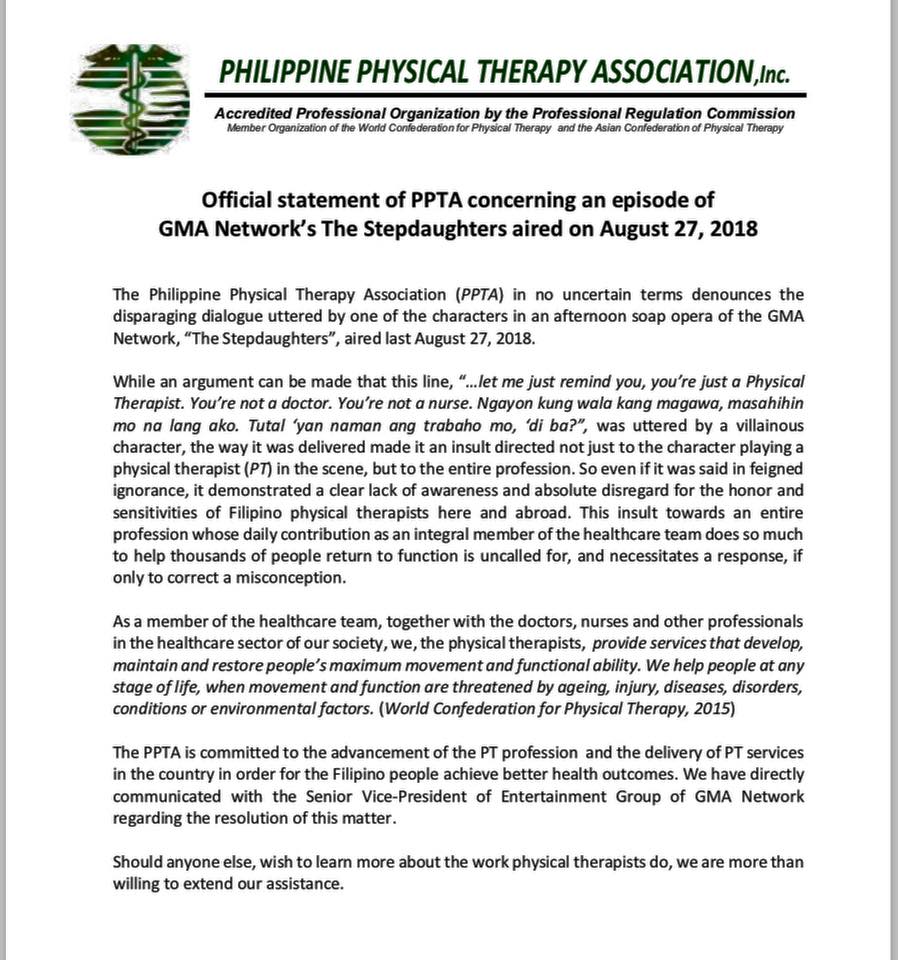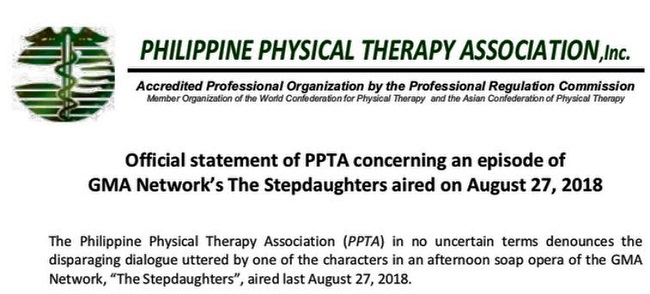MANILA, Philippines – The Philippine Physical Therapy Association (PPTA) had released its official statement about an episode of “The Stepdaughters” aired on GMA on August 27, 2018, and there were varied reactions to this Official Statement.
This is the PPTA’s Official Statement about “The Stepdaughters”.

Some suggested that the association should just ignore the statements because it was a line from an antagonist in the TV series, and the actress was just acting out a role.
However, many PTs felt that people should be informed and be made aware of what Physical Therapy is all about.
Putting things in their proper perspective and learning from the incident, here’s a piece of information that could help clarify the role of Physical Therapists as an allied medical professional.
A Physical Therapist is not ‘only’ a “masahista” (masseuse), as stated in “The Stepdaughters”. She’s more than that – she plays a crucial role in facilitating the treatment, rehabilitation and recuperation of patients; especially those with disabilities.
Physical Therapy Education
Let’s start with the PT’s education.
The Physical Therapy baccalaureate degree is, generally, 5 years or more. If the student wants to be a Doctor of Physical Therapy she can do so, by pursuing 2 to 3 additional years of post grad education.
Most college courses are 4 years only, but PTs slug it out in school for one or two more years. This indicates that they could learn more clinical techniques and gain more medical knowledge than some medical professionals.
Naturally, whether you’re a PT, a nurse, a medical technologist, an OT, a rad tech, or a doctor, you’re valuable to the medical community because each of these professions contributes to the well-being and recuperation of the patient. Each is an integral part of one goal – to cure and maintain the well-being of the patient.
The PT’s subjects include, Human Anatomy and Physiology, Kinesiology, Chemistry, Biology, Pharmacology, Neurology, and many more specialized subjects. The curriculum is somewhat similar to the pre-med subjects of medicine.
The PT course is a difficult and demanding course to enroll in, but they are fully trained to become competent, compassionate and skilled health professionals.
Also, being a PT requires dedication, problem-solving skills, alertness, and commitment.
Responsibilities of Physical Therapists
• Diagnose the patient’s functions through observation of his physical movements and by using diagnostic procedures
• Correlate pertinent medical data from other departments by reviewing patient’s history and determining proper therapeutic management
• Inform the patient’s authorized representative about the patient’s condition and the recommended options for his treatment and on how to cope with his condition
• Aid the patient to recover his mobility, body function and working capability through hands-on therapy, exercises, and utilization of appropriate medical equipment
• Help ease the pain of patients with physical injuries and promote his wellness and well-being
• Prepare an individualized therapeutic program for patients to facilitate their recovery
• Evaluate and document the patient’s course of treatment and prognosis
• Keep a detailed record of the patient’s treatment, progress and management
If you have read carefully, “therapeutic massage” is one of the options used in the patient’s management. This is, most probably, the reason why some people had misconceptions about the PT’s role in the allied health profession.
But that’s only one of their skills, there are dozens of complex skills that they have to learn.
And by the way, there are several types of therapeutic massages, such as myofascial release, manual lymphatic drainage, deep tissue massage, myotherapy, and many more.
Take note that before you could perform competently these intricate procedures, you have to know exactly where the muscles, nerves, veins and bones are located, or else, you can aggravate the patient’s condition.
It took them 5 to 7 years to master their craft and to gain the necessary skills through their internship program.
“Kaya, hindi lang sila masahista.” (So, they’re not only masseuses), as stated in the “The Stepdaughters” TV episode. They’re well-trained professionals in their own specific field.
Thus, they are highly-skilled and they work hard as much as your doctors, nurses or medical technologists.
If you have witnessed paralyzed patients being able to walk again, say thank you to the Physical Therapist, who have made the “miracle” possible.
Bear in mind that Physical Therapy is also one of the highest-paying careers in the medical field.
Hopefully, this post would make people aware of the crucial role that Physical Therapists perform in the recuperation and rehabilitation of patients.
If you’re a Physical Therapist and you want to enlighten the readers more about your profession, feel free to share your two cents’ worth in the comment section below.
For more about Physical Therapists, you may want to watch this YouTube video, courtesy of American Physical Therapy Association (APTA)








